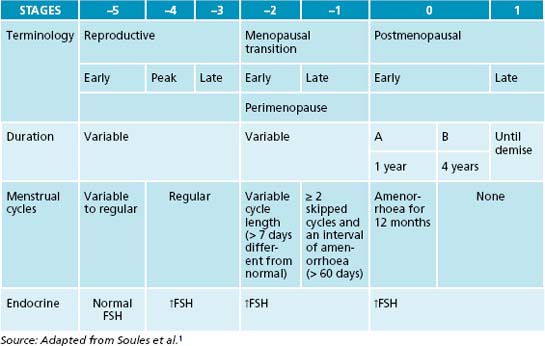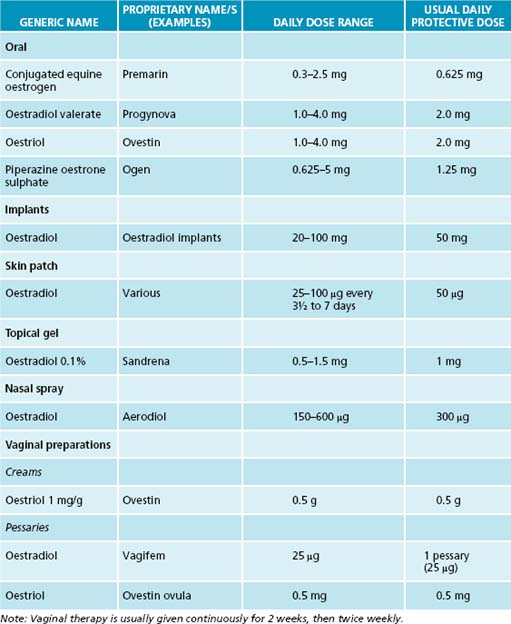Chapter 21 Menopause
OVERVIEW
Menopause represents the natural transition from fertility to age-related non-fertility. The term ‘menopause’ specifically means the cessation of menstruation, and most often occurs between the ages of 45 and 55 years, with the average age for the last period being 51 years.
All healthy women will transition from a reproductive (premenopausal) period—marked by regular ovulation and cyclic menstrual bleeding—to a postmenopausal period marked by amenorrhoea. The onset of the menopausal transition is marked by changes in the menstrual cycle and in the duration or amount of menstrual flow (see Table 21.1). Subsequently, cycles are missed, but the pattern is often erratic early in the menopausal transition. Therefore the menopause is defined retrospectively after 12 months of continued amenorrhoea.
The term ‘perimenopause’ is most often used to describe the time leading up to and directly following menopause.2 During perimenopause, hormone levels fluctuate and women may experience a variety of symptoms including vasomotor symptoms (hot flushes and night sweats), vulvovaginal atrophy, emotional fluctuations and cognitive decline (memory problems). Some women experience very little in the way of these symptoms; for others this time is particularly debilitating. Low oestrogen levels postmenopause also increase the risk of a number of other physical conditions including osteoporosis and cardiovascular disease. The various symptoms of the menopausal transition are associated with a variety of physiological changes and the responses to these changes. Figure 21.1 shows the symptoms associated with changes in hormone levels.
In the postmenopausal phase FSH rise to levels 10–15 times the level that can be expected during the follicular phase of a reproductive cycle, while LH levels increase to around three times that experienced during menstruation. The ovaries do continue to excrete minimal amounts of oestrogens, and continue to excrete significant amounts of androgens.2
It should also be noted that individual women will experience the menopausal transition differently. The prevalence rates of the main symptoms can vary greatly across the different stages of menopause (see Figure 21.2).4
CONVENTIONAL TREATMENT
Conventional practitioners tend to underestimate the effects of perimenopausal symptoms on their patients.5 However, fewer than 25% of women experience a (relatively) symptom-free menopause and over 25% of women experience debilitating symptoms.6 Many women turn to conventional practitioners for explanation and reassurance rather than treatment.3
There is much conjecture and controversy surrounding the use of HT in menopause. There are definite benefits to using HT. HT is effective for vasomotor symptoms, vulvovaginal atrophy symptoms, osteoporosis-related fracture prevention, and benefits cardiovascular and central nervous systems.7 However, continued use of HT can increase the risk for venous thromboembolism and increases the risk of developing breast cancer.7
HT may be recommended in certain circumstances—specifically, distressing symptoms or significant osteoporosis.7 Longer-term use of HT is generally considered a matter for discussion between the physician and the patient, with risks taken into account in addition to potential benefit to bone health and quality of life. Generally, long-term use is discouraged and physicians are encouraged to use lower therapeutic doses.
Various forms of oestrogen have been used for many years as a hormonal supplement to treat menopausal symptoms and are generally thought to be the most effective treatment for vasomotor symptoms. Oestrogen is therefore no longer recommended for prevention of chronic conditions, although it is effective and approved for osteoporosis prevention.4 Women with an intact uterus are usually prescribed the ‘opposed’ regimen (when oestrogen is combined with a progestin to avoid the development of endometrial hyperplasia and endometrial cancer). Testosterone may also be given to women. Examples of commonly used HT in Australia are listed in Tables 21.2 and 21.3.
| GENERIC NAME | DAILY DOSE RANGE | USUAL DAILY PROTECTIVE DOSE |
|---|---|---|
| Dydrogesterone | 10–20 mg | 10 mg |
| Medroxyprogesterone acetate | 2.5–20 mg | 10 mg |
| Norethisterone | 1.25–5 mg | 2.5 mg |
RISK FACTORS
Although much focus tends to be drawn towards the effect that HT can have on increasing breast cancer risk, other modifiable lifestyle factors such as little exercise, smoking, postmenopausal weight gain and high alcohol consumption may increase the risk of not only breast cancer but other menopausal symptoms as well.8
Risk factors for severity of symptoms during perimenopause include genetics (symptoms experienced by the mother may give a guide), body mass index (BMI)—women with a higher BMI may experience a lower level of perimenopause symptoms due to the production of oestrogen by aromatase in adipose tissue (see Chapter 19 on endometriosis).
The duration of symptoms appears independent of HT but is less in those groups with higher physical activity.9 Other lifestyle factors, such as increased alcohol and caffeine use and smoking, are also associated with worsened menopausal symptoms.10
KEY TREATMENT PROTOCOLS
Women undergoing the menopause transition turn to complementary medicines not only to seek effective treatment but also to gain greater control over their symptoms.17 It is therefore essential that a strong participatory relationship is encouraged during treatment and that the naturopath does not fall into the habit of product-prescribing only.
When looking at the literature there seems to be little relation to gross product sales (the most commonly sold complementary therapies for menopause) and specific clinical effectiveness. However, these therapies may be working on broader improvements or act on a psychosomatic level by offering the patients the opportunity to take control of their condition. For example, while acupuncture does not seem to have specific effects on menopausal symptoms such as hot flushes18 it does seem to offer improvements to quality of life scores in perimenopausal women overall.19
For example, treatment with a combination Hypericum perforatum and Cimicifuga racemosa product for 16 weeks resulted in a 50% reduction in Menopause Rating Scale (MRS) scores, with a 41.8% reduction in the Hamilton Depression Rating Scale.20
OESTROGEN-LIKE COMPOUNDS AND OESTROGEN RECEPTOR ACTIVITY
Many compounds—both natural and synthetic—may mimic endogenous sex hormones.11–13 Phytoestrogens may bind to and activate these oestrogen receptor sites. Given the use of hormone replacement therapy in conventional treatment, these compounds are gaining popularity amongst both the public and practitioners for relieving menopausal symptoms.
For example, the phytoestrogenic isoflavones found in Trifolium pratense and soy are thought to have beneficial effects on cognitive abilities, bone mineral density and plasma lipid concentrations in menopausal women.14 Phytoestrogenic activity may also be utilised in traditional Chinese medicine. Astragalus membranaceus and Scutellaria baicalensis are traditionally used in the treatment of menopausal symptoms in traditional Chinese medicine and exert oestrogenic activity in vivo.15
Dietary intake of phytoestrogens and an increased consumption of whole-grain foods may also be associated with a reduction in vasomotor symptoms.16
Many compounds exerting oestrogenic activity will be discussed in relation to symptoms. Many have not actually been studied extensively for menopausal symptoms, but phytoestrogens are discussed in more detail in Chapter 19 on endometriosis.
Although C. racemosa was effective in treating neurovegetative symptoms of depression in menopausal women, combination treatment was more effective than C. racemosa treatment alone.21 These changes seem more significant than the effects on vasomotor symptoms alone. And while H. perforatum does not seem to exert a significant effect on hot flush symptoms, it does proffer significant improvement on quality of life scales due to its effect on other symptoms associated with menopause and should therefore also be considered.22 C. racemosa also has positive effects on overall quality of life scales and other broader menopause rating scales when used alone in addition to its effects on individual symptoms.23 Several relaxation therapies have also proven to be effective in alleviating or reducing a number of perimenopausal symptoms, rather than having specific outcomes.
Major symptoms
Hot flushes
Exercise
Because exercise has demonstrated effects on sex steroids, it may moderate at least the severity, if not the frequency, of hot flushes.9,24–26 One epidemiological study found that women who belonged to a gymnasium club reported lower incidence of hot flushes than those who were not, although their individual exercise regimens were unreported.27 However, studies on exercise, while generally demonstrating reduced severity and incidence of hot flushes, suggest it has had the greatest effect on quality of life scores.
Herbal medicine
A 2007 systematic review of 17 trials of which 11 could be included showed a demonstrated effect of Trifolium pratense in reducing hot flush symptoms in menopause.34 A 2005 review of trials found 12 clinical trials of C. racemosa in vasomotor symptoms,
BLACK COHOSH SAFETY
Although concerns relating to the hepatotoxicity of Cimicifuga racemosa have been raised, systematic reviews have suggested it can be generally thought to be a safe medicine, with the main side effects being mild and reversible, and no direct causal link to Cimicifuga was found in cases of severe hepatotoxicity.28–31 In the most recent trial, long-term supplementation of Cimicifuga for a period of 1 year was found to have no effects on hepatic blood flow or liver function.32 However, an association does exist as hepatotoxicity has occurred in several people taking supplements containing Cimicifuga. This is thought to be related to issues of product quality, concomitant medications or individual genetic susceptibility. Although the specific mechanism relating to hepatotoxicity associated with Cimicifuga use is unknown, one theory gaining credence is an immunologic reaction to triterpene glycosides in the plant in susceptible individuals, rather than the direct result of inherent toxicity.33 Therefore these issues should be considered when advising or treating patients using these therapies, as they should for any other pharmacological intervention.
all but one of which demonstrated benefit,35 and a later non-specific review found significant benefit also.36
C. racemosa may act through a number of pathways independent of its activity as a phytoestrogen. Recent evidence suggests that it may have an effect on opiate receptors.37 Cimicifuga extract has also been demonstrated to exert dopaminergic activity in vitro.38 This may in part also explain the effects of Cimicifuga in menopause as dopaminergic drugs are often used to treat menopausal symptoms such as hot flushes. Some studies have suggested that Cimicifuga has an equipotent effect to oestrogen39 although this does not seem reflective of the entirety of the data.40,41 It should be noted, however, that significant heterogeneity exists in the results for differing formulations, suggesting that quality issues need to be considered before prescribing.
Angelica sinensis and Matricaria recutita in combination has been demonstrated to reduce hot flushes and improve sleep in menopausal women,42 but other trials have failed to demonstrate these results when Angelica sinensis was used alone.43,44
Humulus lupulus supplementation over 12 weeks was found to reduce discomforting symptoms of menopause, particularly hot flushes, even at low doses.45 This is thought to be due to the oestrogenic nature of H. lupulus.46 Salvia officinalis was also demonstrated to improve symptoms of hot flushes and nights sweats in perimenopausal women.47











